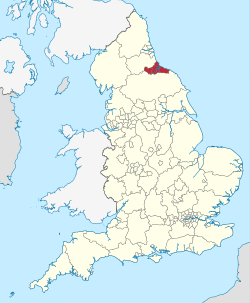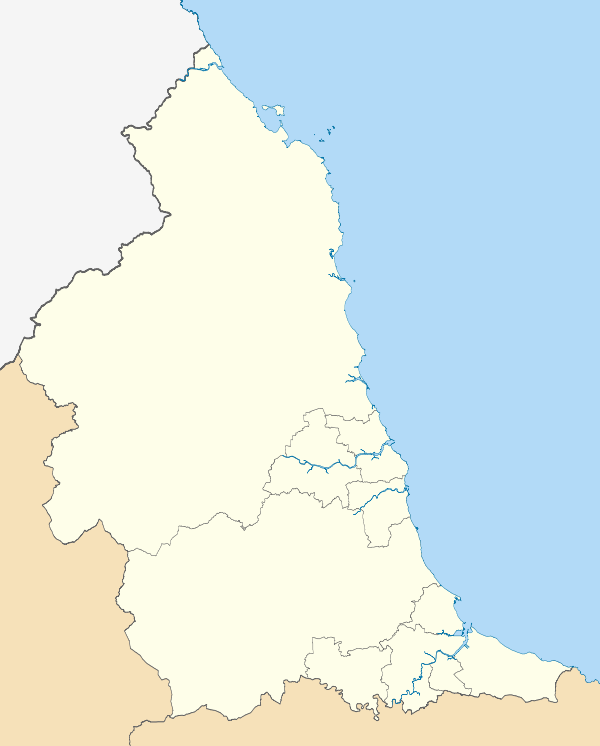Tees Valley
| Tees Valley | |
|---|---|
| City region, Combined authority and Local enterprise partnership | |
 | |
| Coordinates: 54°36′18″N 1°15′25″W / 54.605°N 1.257°WCoordinates: 54°36′18″N 1°15′25″W / 54.605°N 1.257°W | |
| Sovereign state |
|
| Country |
|
| Region | North East England |
| Established | 2011 (Local enterprise partnership) |
| Administrative HQ |
Stockton-on-Tees (Cavendish House) |
| Districts | |
| Government | |
| • Type |
Combined authority Local enterprise partnership |
| • Body |
Tees Valley Combined Authority Tees Valley Unlimited |
| • Mayor | Ben Houchen, (Conservative) |
| Area | |
| • Total | 306.93 sq mi (794.95 km2) |
| Population (mid-2017 est.) | |
| • Total | 701,818 |
| • Density | 2,300/sq mi (880/km2) |
| Time zone | UTC+0 (Greenwich Mean Time) |
| • Summer (DST) | UTC+1 (British Summer Time) |
| Website |
www |
The Tees Valley is a city region and combined authority area in the North East of England covering parts of North Yorkshire and County Durham. It consists of the following five unitary authorities: Darlington, Hartlepool, Middlesbrough, Redcar and Cleveland and Stockton-on-Tees, the latter four previously formed the non-metropolitan county of Cleveland between 1974 and 1996. Some of the area formed the County Borough of Teesside between 1968 and 1974.
The Tees Valley area covers the lower, flatter (and much more urban) area of the valley of the River Tees. Tees Valley Enterprise Zone is an enterprise zone which encourages industrial development in 12 sites around the region, with a thirteenth site planned.
The five councils announced plans to establish a Tees Valley Combined Authority after a public consultation. Of more than 1,900 responses received during a seven-week long public consultation, 65 percent were in favour of a combined authority. The Combined Authority went live on 1 April 2016 after Local Government Minister James Wharton MP signed the necessary Order.[1]
Economy
This is a chart of trend of regional gross value added of Tees Valley at current basic prices published (pp. 240–253) by Office for National Statistics with figures in millions of British Pounds Sterling.
| Year | Agriculture | Industry | Services | Regional gross value added |
|---|---|---|---|---|
| 1995 | 26 | 2,746 | 3,574 | 6,347 |
| 2000 | 23 | 2,716 | 4,622 | 7,362 |
| 2003 | 22 | 2,568 | 5,478 | 8,069 |
- ^ includes hunting and forestry
- ^ includes energy and construction
- ^ includes Financial Intermediation Services Indirectly Measured
- ^ Components may not sum to totals due to rounding
Enterprise zone
Tees Valley Enterprise Zone was initiated by the local enterprise partnership Tees Valley Unlimited and its creation was announced by the government in 2011. At its launch, the zone contained 12 sites. Four of these sites offer enhanced capital allowances, aimed at large manufacturers. These sites are Wilton International and South Bank Wharf, both in Redcar and Cleveland, Port Estates in Hartlepool and New Energy and Technology Park in Billingham, Stockton-on-Tees. The remaining sites offer reduced business rates.[2] In March 2015 the government announced that a thirteenth site is to be added, South Bank Wharf Prairie, aimed at oil and gas decommissioning business.[3]
Local government

The official region consists of the following unitary authorities:
| Unitary Authority | Population | Area (sq mi) | Population Density (per km2) |
|---|---|---|---|
| Darlington | 105,367 | 76.3 | 535 |
| Hartlepool | 92,590 | 36.1 | 985 |
| Stockton-on-Tees | 194,119 | 79.2 | 952 |
| Redcar and Cleveland | 135,042 | 94.5 | 551 |
| Middlesbrough | 174,700 | 20.8 | 3242 |
References
- ↑
- ↑ "Teesside celebrates as enterprise zone approved". The Journal. 17 August 2011. Retrieved 15 March 2015.
- ↑ Price, Kelley (18 March 2015). "Potential for 'many hundreds' of jobs at new Teesside enterprise zone". The Gazette. Retrieved 23 March 2015.
